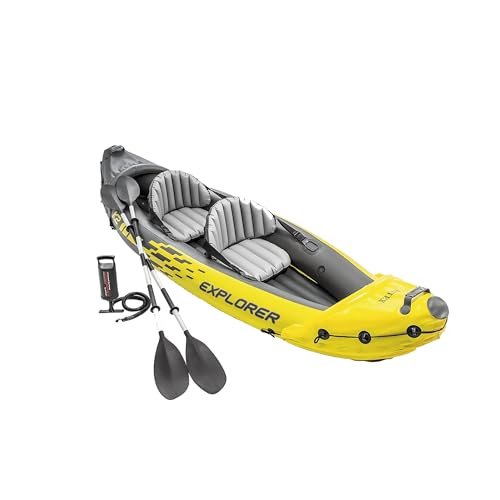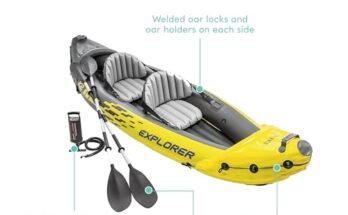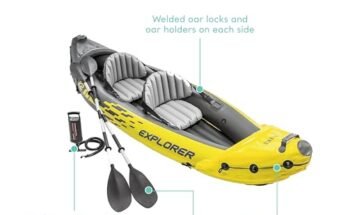Choosing the right kayak can make all the difference between a fun day on the water and a frustrating experience. You want a kayak that fits your needs, feels comfortable, and matches where you plan to paddle.
But with so many options out there, how do you know which one is best for you? This guide will help you cut through the confusion and find the perfect kayak that suits your style and skill level. Keep reading, and soon you’ll be ready to glide confidently across the water.

Types Of Kayaks
Choosing the right kayak depends on understanding the different types available. Each type fits a specific use and skill level.
Here are common kayak types to help you decide which one suits your needs best.
Sit-on-top Vs Sit-in
Sit-on-top kayaks have an open deck. You sit on top and are easier to get in and out of. They are good for warm weather and casual paddling.
Sit-in kayaks have an enclosed cockpit. They offer more protection from water and cold. These kayaks are better for rough waters and longer trips.
Recreational Kayaks
Recreational kayaks are great for beginners. They are stable and easy to paddle. These kayaks work well on calm lakes and slow rivers.
- Short and wide for stability
- Lightweight and easy to carry
- Good for casual paddling
- Usually made from durable plastic
Touring Kayaks
Touring kayaks are built for speed and distance. They have a longer, narrower shape. These kayaks track better in open water and handle waves well.
They often include storage hatches for gear. Touring kayaks suit experienced paddlers and long trips.
Inflatable Kayaks
Inflatable kayaks are easy to transport and store. They can be deflated and packed into a bag. These kayaks work for casual paddling and some whitewater use.
| Pros | Cons |
| Lightweight and portable | Less stable than hard kayaks |
| Easy to store | Can be punctured |
| Good for beginners | Slower and less efficient |
Fishing Kayaks
Fishing kayaks have extra features for anglers. They often include rod holders, storage areas, and mounts for fish finders. These kayaks are stable and easy to maneuver in fishing spots.
- Wide hull for balance
- Comfortable seating for long hours
- Space for fishing gear
- Sometimes pedal or motor powered
Key Features To Consider
Picking the right kayak means thinking about key features. These features affect how you use and enjoy your kayak. Focus on material, weight, storage, and how it handles on the water.
Each feature plays a role in your overall experience. Knowing what to look for helps you choose a kayak that fits your needs and style.
Material And Durability
Kayaks come in different materials like plastic, fiberglass, and composite. Plastic kayaks are tough and resist impacts. Fiberglass kayaks are lighter but can crack. Composite kayaks mix materials for strength and lightness.
Think about where you will kayak. Rough waters or rocky shores need a strong material. Also, consider how often you will use the kayak and how long you want it to last.
Weight And Portability
A kayak’s weight affects how easy it is to carry and move. Lightweight kayaks are easier to transport and load on a car. Heavier kayaks may feel more stable but can be hard to handle alone.
- Check the kayak’s weight before buying
- Think about if you will carry it alone or with help
- Consider your vehicle’s roof rack limits
- Look for models with handles or wheels for easier transport
Storage Options
Storage space on a kayak lets you keep gear safe and dry. Some kayaks have built-in compartments, while others use external storage like dry bags.
| Storage Type | Description | Best For |
|---|---|---|
| Hatch Compartments | Sealed areas inside the kayak | Keeping valuables dry |
| Deck Rigging | Elastic cords on top of the kayak | Holding items like water bottles or shoes |
| Dry Bags | Waterproof bags stored inside or outside | Extra storage and easy to remove |
Stability And Maneuverability
Stability means how steady the kayak feels in the water. Wider kayaks offer better stability but can be slower. Narrow kayaks are faster and easier to turn but need more balance.
Consider these points:
- Choose wider kayaks for calm lakes and beginners.
- Pick narrower kayaks for rivers or fast paddling.
- Test how the kayak turns and responds before you buy.
- Check the kayak’s design for tracking straight or making quick turns.
Matching Kayak To Your Needs
Choosing the right kayak starts with understanding your needs. Matching your kayak helps you enjoy paddling safely and comfortably.
Think about your skills, where you will kayak, and how long your trips will be. Also, consider how much gear you need to carry.
Skill Level And Experience
Beginner kayakers should pick stable, easy-to-control kayaks. More experienced paddlers can choose faster, narrower models. Think about how confident you feel on water.
- Beginners: wide and stable kayaks
- Intermediate: balanced speed and stability
- Advanced: narrow and fast kayaks
Intended Water Type
Your kayak should fit the water you will paddle in. Calm lakes need different kayaks than whitewater rivers or coastal areas.
| Water Type | Recommended Kayak |
| Calm lakes | Stable recreational kayak |
| Rivers and streams | Whitewater kayak with good maneuverability |
| Coastal waters | Sea kayak with storage and tracking |
| Flatwater and touring | Long, narrow touring kayak |
Typical Trip Length
Think about how long your trips usually last. Short trips need less storage space. Longer trips require room for supplies and comfort.
- Short trips: lightweight kayaks with minimal storage
- Day trips: kayaks with moderate storage and comfort
- Multi-day trips: large kayaks with ample storage and comfort features
Capacity And Weight Limits
Check the kayak’s weight limit before buying. It must hold your weight plus gear safely. Avoid kayaks that feel too small or too large.
| Kayak Size | Weight Capacity (lbs) | Typical User |
|---|---|---|
| Small | Up to 220 | Light paddlers with minimal gear |
| Medium | 220 – 300 | Average weight paddlers with some gear |
| Large | 300+ | Heavy paddlers or those with lots of gear |
Sizing And Fit
Choosing the right kayak size is important for a good experience on the water. A kayak that fits you well feels comfortable and easy to control.
Look at how your body fits inside the kayak before buying. Proper fit helps with balance and paddling power.
Seat Comfort And Adjustability
The seat is where you spend most of your time in a kayak. A soft, padded seat makes long trips more pleasant.
Adjustable seats let you change the backrest or height. This helps you find the best position and avoid pain.
- Look for padded seats with good support
- Choose kayaks with adjustable backrests
- Check if the seat height can be changed
Legroom And Cockpit Size
Your legs need enough space to move freely inside the kayak. Too little legroom can cause discomfort and cramps.
The cockpit should fit your body without squeezing. A well-sized cockpit helps with easy entry and exit.
- Measure your leg length before choosing a kayak
- Try sitting in the cockpit to test the fit
- Choose a wider cockpit for more space
Paddle Compatibility
Your kayak should work well with your paddle size and style. The right fit helps you paddle efficiently and avoid fatigue.
Check if the kayak allows easy paddle movement without hitting the sides. This is important for smooth strokes.
- Match paddle length to your height and kayak width
- Ensure enough space for paddle strokes inside the cockpit
- Test paddle motion before buying the kayak
Budget And Brand Choices
Choosing the right kayak depends on your budget and the brand you trust. Knowing the price ranges helps you find a kayak that fits your needs.
Brands offer different features and quality. Picking a reputable brand ensures a better experience and support.
Price Ranges
Kayaks come in many price ranges. You can find options for beginners and experts.
Lower prices often mean simpler designs. Higher prices usually add better materials and features.
- Under $300: Basic kayaks for casual use
- $300 – $700: Mid-range kayaks with more durability
- $700 and above: High-quality kayaks for advanced paddling
Reputable Brands
Choosing a well-known brand can give you peace of mind. These brands often test their kayaks well.
Good brands also offer better design and safety features. They often have positive customer feedback.
- Perception
- Old Town
- Pelican
- Wilderness Systems
- Ocean Kayak
Warranty And Support
Check the warranty before buying. A solid warranty covers defects and damage for a set time.
Good customer support helps with repairs and questions. It adds value to your kayak purchase.
- Look for at least 1-3 years warranty
- Check what parts are covered
- Find brands with responsive customer service

Test And Inspect Before Buying
Choosing the right kayak involves more than just picking a color you like. Before you make a purchase, it is important to test and inspect the kayak thoroughly.
This ensures that you are getting a kayak that meets your needs and is safe to use. Let’s explore the key steps involved in testing and inspecting a kayak before buying.
Demoing Kayaks
Trying out a kayak on water gives you a feel for its performance. Look for local shops that offer demo days or rentals.
- Visit a demo day event at a local lake or river.
- Rent the kayak you are interested in for a day.
- Test different models to find the best fit.
Checking For Damage
Examine the kayak carefully for any signs of damage. This step is crucial to ensure safety and longevity of the kayak.
- Inspect the hull for cracks or deep scratches.
- Check the seams and joints for leaks.
- Look at the fittings and accessories for wear and tear.
Assessing Stability And Comfort
A stable and comfortable kayak enhances your paddling experience. Consider the following aspects for comfort and stability.
| Feature | Importance |
| Seat Comfort | Prevents fatigue during long paddles |
| Width | Affects stability on water |
| Footrests | Provides better control |
Essential Accessories
Kayaking is a fun outdoor activity. Having the right accessories makes it safer and more enjoyable.
Here, we will discuss some essential accessories you need when choosing a kayak. These include paddles, personal flotation devices (PFDs), storage gear, and safety equipment.
Paddles And Pfds
Paddles are your kayak’s engine. They come in different lengths and materials. Choose a paddle that matches your height and strength.
A PFD, or personal flotation device, is a must-have for safety. It helps you stay afloat if you fall into the water.
- Paddles made of plastic are affordable and durable
- Carbon fiber paddles are lightweight but expensive
- PFDs should fit snugly and allow easy movement
Storage Gear
Storage gear keeps your items dry and organized. Waterproof bags are great for phones and clothes. Deck bags attach to the kayak for easy access.
Think about how much gear you will carry. This helps you pick the right storage options for your kayak trips.
- Dry bags protect electronics from water
- Deck bags provide quick access to snacks and maps
- Consider the size and weight of your gear
Safety Equipment
Safety equipment is vital for any kayaking adventure. A whistle can signal for help. A bilge pump removes water from your kayak.
A first aid kit is another important item. It helps handle minor injuries while on the water.
- Whistles are loud and easy to use
- Bilge pumps help keep your kayak dry
- First aid kits should include bandages and antiseptic wipes

Frequently Asked Questions
What Factors Should I Consider When Choosing A Kayak?
Consider your kayaking style, water type, kayak size, and weight capacity. Also, think about storage space and budget. These factors help you pick a kayak that fits your needs and ensures a safe, enjoyable experience.
How Do I Know Which Kayak Size Suits Me?
Choose a kayak size based on your height, weight, and intended use. Longer kayaks offer speed; shorter ones provide better maneuverability. Always check the manufacturer’s size recommendations for the best fit and comfort.
What Are The Main Types Of Kayaks Available?
The main types include recreational, touring, inflatable, and whitewater kayaks. Each type is designed for specific water conditions and skill levels. Knowing these helps you select the right kayak for your adventures.
Is A Sit-on-top Or Sit-in Kayak Better For Beginners?
Sit-on-top kayaks are ideal for beginners due to their stability and ease of use. Sit-in kayaks offer better protection and control but may require more skill. Choose based on comfort and where you’ll kayak.
Conclusion
Choosing the right kayak makes your trips safer and more fun. Think about where you want to paddle and what feels comfortable. Consider the kayak’s size, weight, and stability. Test different types if you can. A good kayak fits your needs and skills.
Take your time to decide. Enjoy every moment on the water with the perfect kayak. Happy paddling!


